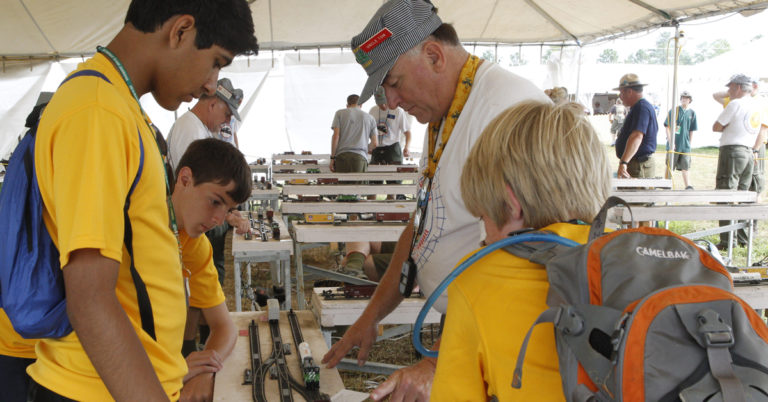Step by step: How to be a merit badge counselor

The merit badge counselor is one of the coolest jobs in Scouting.
These volunteers introduce Scouts to a topic about which they are passionate and knowledgable.
At the very least, a merit badge counselor helps a young man earn a merit badge for his sash and get one step closer to the next rank.
At the most, a merit badge counselor introduces a young man to a subject that could become a lifelong hobby or career.
The first step is to become registered with your local council and complete Youth Protection training. Existing counselors must re-register annually.
Then you must meet these requirements:
- Be an individual of good character
- Be age 18 or older
- Have the skills and education in the subject(s) you want to teach
- Have good rapport with Scout-age youths and their unit leaders
- Be approved by the local council
Then, you simply follow the guidance in the six-page “Guide for Merit Badge Counseling,” available here as a free PDF.
The most important part of the guide, in my opinion, is the step-by-step list I have pasted below.
Step by step: How to be a merit badge counselor
Through your association with youth members, keep in mind you are assisting unit leaders in the advancement program. Leaders coach Scouts on the recognitions they will earn for a particular rank and provide them with the name and phone number of a counselor to contact.
Whether a Scout earns the award or not, a volunteer is always interested in the youth’s progress. The merit badge counselor should feel free to discuss the Scout’s work with his unit leader at any time.
Let’s now review the process of how a volunteer helps Scouts earn merit badges, beginning with the initial contact.
- The Scout contacts you, probably by phone. You may tell him what is expected of him over the phone, or you may want to make an appointment to discuss this with him and his buddy in person. Personal contact will make earning the badge a better experience for all concerned.
- When you work with a Scout, he must always have someone — a buddy — with him. This buddy may be a friend, group of other Scouts working on the same recognition, or a parent or other adult. This point is emphasized in the BSA Youth Protection training.
- On his first visit, the Scout should bring a merit badge application, known as the “blue card,” No. 34124, signed by his unit leader. This lets you know the Scout and his unit leader have discussed earning this badge and authorizes him to meet with you.
- In your discussion of what is expected, you may want to start by finding out what the Scout already
knows. He may already have worked on some of the requirements before meeting with you, but before signing off, it is up to you whether or not he has completed each requirement as written. Spend some time helping him learn the remaining requirements, or give guidance in completing projects. You can set up additional meetings with the Scout — not only for the purpose of passing him on the requirements, but rather to help him understand the subject. - The Scout, along with his buddy, should make another appointment with you when he thinks he is prepared to prove his ability.
- This review session might be approached by the Scout with some apprehension. He is familiar with final exams in school and may see this meeting with you as another such experience. You can help by putting him at ease. Talk with him rather than grill or examine him; there is a big difference, yet you can still find out what he knows. Express honest enthusiasm for the things he has done, particularly if projects are involved. Your approval will give the Scout confidence.
- When he meets you, he should bring with him the projects required for completion. If these cannot be transported, he should present satisfactory evidence, such as a photograph of the project or adult verification. His unit leader might, for example, verify that a satisfactory bridge or tower has been built for Pioneering, or that the required meals were prepared for the Cooking merit badge. Your responsibility, in addition to coaching, is to satisfy yourself that the requirements have been met. Question the Scout and, if you have any doubts, contact the adult who signed the statement.
- When you are satisfied the Scout has met the requirements, you list and initial each completed requirement. The blue card is not signed until all requirements are met. You may work with many Scouts each year as they earn merit badges. However, you might only work with a few. Your contact with these Scouts is tremendously important. Your influence is measured not by the number of Scouts with whom you work, but by the effect upon the lives of those with whom you have an opportunity to work.
Requirements: No more, no less
One last reminder from the guide:
The Scout is expected to meet the requirements as stated — no more and no less. Furthermore, he is to do exactly what is stated. If it says ‘‘show or demonstrate,’’ that is what he must do. Just telling about it isn’t enough. The same thing holds true for such words as ‘‘make,’’ ‘‘list,’’ ‘‘in the field,’’ and ‘‘collect, identify, and label.’’
On the other hand, you cannot require more a Scout than stated. You must not, for example, say, ‘‘I want to be sure you really know your stuff, so instead of the 20 items in your collection, you must collect 50 to get my signature.’’ You can suggest, encourage, and help the Scout to get 50 things, but you must not require it.
